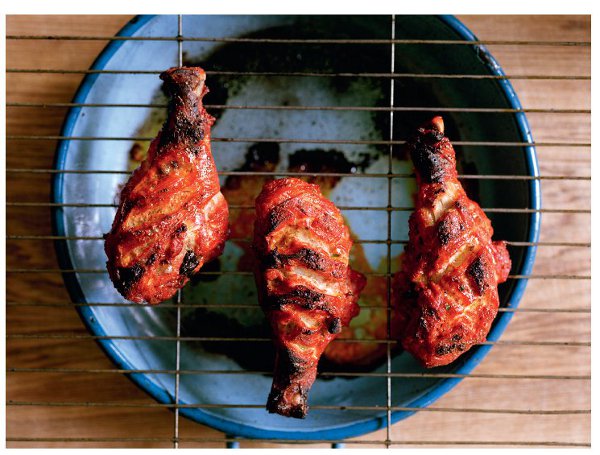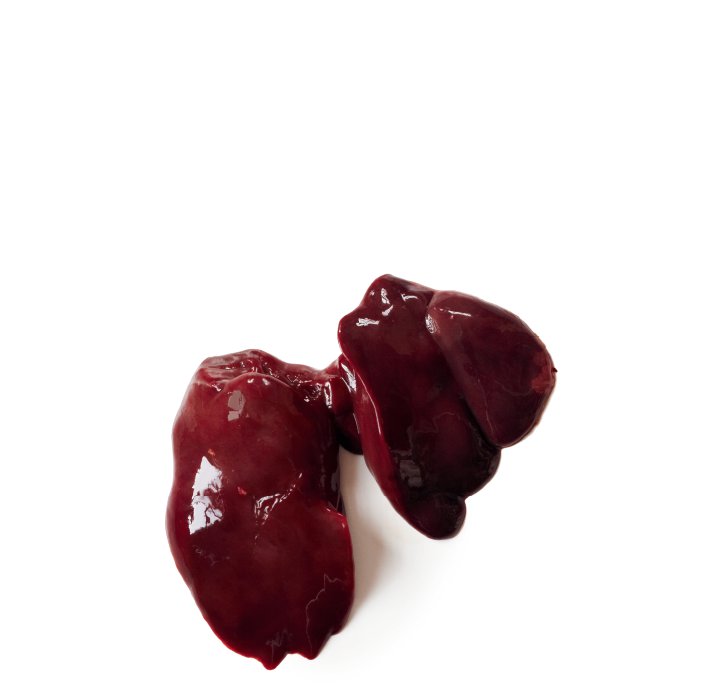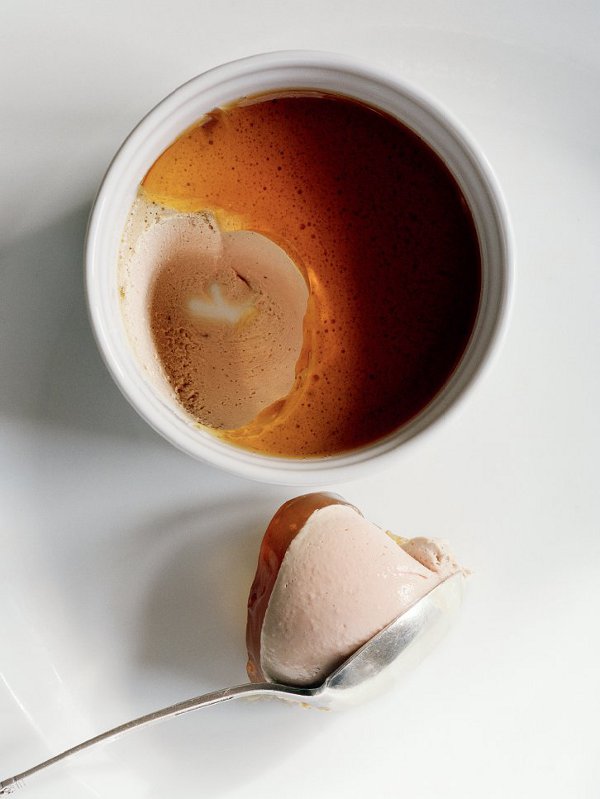Good Cook (13 page)
Authors: Simon Hopkinson

serves 2, generously
for the dressing
1–2 tbsp smooth Dijon mustard
1 rounded tsp superfine sugar or, if you happen to have some, 2 tsp syrup from a jar of preserved ginger
salt and freshly ground white pepper
a squeeze of lemon juice, to taste
a few drops of Tabasco sauce
4–5 tbsp sunflower oil
2–3 tbsp hot—but not boiling—water
salt and freshly ground white pepper
2 cooked chicken legs
a little sunflower oil
2 big handfuls of salad greens: mâche (or other lettuce), watercress, arugula (if you must), small spinach leaves or a mixture of all four
a tiny squeeze of lemon juice
a little olive oil
a little finely chopped shallot (or chives or spring onion)
some peeled and sliced cucumber
Using a small food processor, ideally, blend together the first 5 dressing ingredients until smooth. With the motor running, gradually add the oil and water, alternately, until an homogenous dressing is formed. Pour into a small bowl and set aside.
Season the chicken legs and very quietly fry them, skin side down in the sunflower oil, in a frying pan until the skin is really crisp; anything up to a slow 10–15 minutes, and do not rush them. Turn over and do the other side, but for not as long a time—it is the skin that you need to be crisp, for a sensational hot salad. Cut the chicken meat away from the bones and roughly slice. Keep hot.
To serve, put the salad greens into a bowl, season them, then briefly dress with lemon juice and oil. Pile on to 2 plates, sprinkle with the shallot and surround with cucumber slices. Pile the chicken on top of the greens and, without drowning the salad, spoon over some of the dressing. Eat forthwith, while the chicken remains crisp and hot.
serves 4
approx. 3¼–3¾ lb chicken drumsticks, skinned
juice of 2 small lemons, plus extra lemons to squeeze over once the chicken is cooked
salt
18 oz plain and runny yogurt (absolutely not thick Greek)
3–4 tbsp tandoori spice mix (a good brand, preferably from an Asian shop)
I know that it is incredibly easy, almost everywhere, to phone up a local Indian restaurant or takeaway and have endless boxes of tandoori chicken delivered to the door, day in, day out. And, what’s more, it will, almost without exception, have been cooked in a traditional and authentic tandoor oven, to boot. So, why make your own, I hear you ask?
Well, I just love making it, that’s all. And, it is hot and juicy, directly from my hot oven and broiler. And, it is not lukewarm and dried out a bit, as some delivered versions can often be. And, if you are having it in warm weather and own a barbecue, then the charcoal flavor given to the drumsticks as they grill can, really quite nicely, offer that scorched and smoky flavor redolent of the big clay oven in the kitchens of your local Gujerati Garden or Bombay Palace. If I could also give you a decent recipe for naan bread, I would, but my feeble attempts at making that particular dough have usually ended up in the bin. Breadmaking has never been my forte. One should be utterly useless at a few things, don’t you think?
Using a small, sharp knife, cut deep slashes into the chicken flesh without going right down to the bone. Put into a bowl and sprinkle with the lemon juice and salt, massaging these into the chicken until well mixed. Leave to macerate for about an hour. Whisk together the yogurt and tandoori spice in a bowl and pour over the chicken. Again, mix well until the entire bowlful is a wonderful red. Cover with plastic wrap and put into the fridge for at least 5–6 hours, or overnight, occasionally turning the chicken around a bit.

Preheat the oven to 450°F.
Lift out the drumsticks from the tandoori mixture and gently shake off any excess. Place a wire rack over a roasting pan and lay the chicken legs upon it (it is a good idea, washing-up wise, to line the tin with foil, as the drippings from the chicken will burn). Bake in the oven for about 20 minutes, or until the drumsticks are richly burnished and almost blackened in parts; if not, finish them under a hot broiler.
Eat using your fingers, and squeeze more lemon over them as you go. And, if you would like a simple dip of some sort, add some freshly chopped mint and a chopped green chilli to some seasoned yogurt.

chicken livers
serves 2
4 tbsp butter
salt and freshly ground black pepper
7 oz trimmed chicken livers
1 shallot, finely chopped
1 clove of garlic, finely chopped
3
1
/
3
oz open-cup (or other) mushrooms, thickly sliced
4 tbsp Madeira
4 oz double or heavy cream
1 tsp very finely chopped rosemary leaves
2 large, thick slices of white bread, toasted
For me, the archetypal kind of Sunday supper dish should always involve toast, somewhere. Whether it be simple scrambled or poached eggs, anchovies or thin slices of Parma ham, even baked beans, for heaven’s sake, hot buttered toast must feature. This chicken liver/mushroom thing, however, is a notch above the norm and is originally based upon my Dad’s mushrooms on toast; a regular, family supper of which we never tired. Funny thing was, however, they always turned out as near as dammit to a heated-up can of Chesswood creamed mushrooms. But, as I always watched him make them, I knew different. He was a master of the mushroom, Dad, when creaming away at the Aga.
Melt the butter in a frying pan until foaming. Season the livers and briefly fry in the butter until golden brown; they should be slightly bouncy to the touch and very pink in the middle (they will be further cooked, later). Transfer the livers to a plate and keep warm.
In the butter left in the pan, fry the shallot and garlic until golden. Add the mushrooms and quietly cook for a further 2–3 minutes; add a touch more butter if necessary. Add the Madeira to the pan and reduce until syrupy, then pour in the cream and add the rosemary. Bring to a simmer and allow the cream to thicken to a rich sauce before returning the livers to the pan. Check for seasoning, heat the livers through and spoon over hot toast—buttered or not, but the dish is quite rich anyway.
makes 4 small ramekins
4½ oz chicken (or duck) livers, trimmed of any blemishes
2 egg yolks
4 tbsp unsalted butter, softened
2 oz duck/goose fat, softened (but not liquid)
½ tsp salt
4–5 grindings of black pepper
a little freshly grated nutmeg
pinch of sugar
1 tbsp Cognac or Armagnac
4½ oz double or heavy cream
a little extra butter, melted
Some may wish to say that this dish is similar to the now ubiquitous chicken liver parfait offered on the menu of almost every single “fine dining” (always pronounced “fane daning’, by me) restaurant. Well, as quite often foie gras is included in the make-up of most of those parfaits, that observation would fall to the ground to start with. The description of very, very smooth, however, is common to both preparations; silky smooth, even, and pale pink within.
Now then, when I feel in the mood, I make a port jelly to pour on top of these delectable mousses. The following recipe simply advises some melted butter to seal the surface of the mousse, once cooked and cooled. But if you want to have a go at this jelly, then I shall run through the ingredients and method now …
You will need about 18 oz of well-seasoned, cold chicken stock; 3 egg whites; about 7 oz of minced turkey; 3 leaves of gelatine and 3 oz of port. Put the stock into a roomy pan and mix together the egg whites and turkey until well blended. Tip this into the stock and briefly whisk together. Change to a wooden spoon (the whisk eventually becomes clogged with turkey bits, otherwise) and place the pan over a moderate heat. Begin to stir the mixture while it heats up, and just before it approaches a gentle simmer, turn the heat down to very low. Leave to cook, just at an occasional blip, for about 45 minutes. By now, the liquid beneath the turkey mince—a rather unappetizing, grey mulch—should be crystal clear. Put the gelatine leaves into a bowl and pour over some cold water.

Lay a scrupulously clean dish towel (or a sheet of double-folded muslin) inside a colander and place over a bowl. Now, carefully make a hole in the turkey mulch with a spoon, then ladle out the clear stock and pour it into the towel-lined colander, so that any bits will be caught. Once this is finished, lift out the colander and discard the exhausted turkey mulch.
Lift out the gelatine leaves from their cold water, squeeze out any excess water, and add to the hot stock, where they will melt. Stir in the port and leave the stock to become cool, but still liquid. At the end of the mousse recipe below, where instructed to pour melted butter over the top, simply replace the butter with some of this delicious jelly, which will then set upon the surface, once chilled in the fridge for a few hours.
Note: please watch out for lingering dishwashing odors if using a dish towel to strain the stock, as these can taint the jelly. And how horrible that would be!
Preheat the oven to 300°F, and also boil a kettle of water.
Using a food processor or blender, blend the livers, egg yolks, butter, fat, seasonings, sugar and alcohol until very smooth. Heat the cream in a small, preferably lipped pan, until hot, not boiling. With the processor/blender motor running on low, pour in the hot cream until well blended. Check for salt.
Pour the mixture through a fine sieve into a bowl, then ladle it into 4 ramekins until almost full. Place the mousses in a deep roasting pan and pour water from the boiled kettle around the ramekins until almost matching the level of the interior filling. Cover the ramekins with a single, flat sheet of foil, but don’t tighten it around the tin.
Bake the mousses in the oven for about 20 minutes, or until only just set (think caramel custard—just wobbling, if nudged), and check them frequently. Once cooked, remove from the water and leave to cool to room temperature. Spoon over a generous film of melted butter and place in the fridge to set. Best eaten after 24 hours, with very thin, hot toast.
serves 8–10
18 oz chicken livers, trimmed, coarsely minced
11 oz skinless, fatty pork belly, coarsely minced
9 oz excellent-quality sausages, skins removed
4 cloves of garlic, crushed and chopped
2 tbsp chopped parsley
2 rounded tsp herbes de Provence
6 cloves, but only the tiny ball on the tip, pinched off and crumbled between the fingers
5–6 healthy scrapings from a whole nutmeg
2 tsp sea salt
4 oz Cognac
3 oz Madeira or sherry (amontillado, say, but not dry)
1 tbsp green peppercorns, from a jar or tin, drained
First of all, it is essential to start preparing this lovely terrine the day before you make it. You could leave the mixture to mature for a few hours, but a good 12 hours, at least, is most beneficial to the final taste.
I have always enjoyed making terrines or pâtés in old-fashioned, foil takeaway containers. They freeze well in these for one thing but, more importantly, they make excellent gifts for friends; you don’t need to ask for the dish back or forget where it went in the first place … I don’t know anyone who doesn’t like to have homemade pâté in the fridge, to cut at occasionally, with a thin slice of toast and an early evening glass of wine.
Note: a home mincer is a most useful attachment to a domestic kitchen, whether manual or electrically driven. How many butchers do you know who will mince chicken livers for you, anyway? If taking the food processor route, please make sure that the pulse button is employed using a tentative digit.

Mix everything together in a large bowl or, for ease, the bowl of an electric food mixer using the flat beater. Tip into a plastic container, say, put on a lid and keep in the fridge overnight.
The next day, first preheat the oven to 375°F.
Pile the mixture into a terrine mold of about 1 quart capacity or, if you like, use 3 or 4 foil takeaway containers (see above). Smooth the surface using your hand, first dipped into warm water—this really helps—leaving a very slightly domed finish to the mixture. Place the terrine(s) into a deep roasting pan and surround with tap-hot water. Loosely drape a sheet of kitchen foil over the terrine(s), but don’t tighten it around the tin. Cook in the oven for about 1½ hours if in one single container, or for slightly less—say 1 hour—if using foil containers.
Remove the sheet of foil for the last 10–15 minutes, so allowing the top of the terrine to brown a little. Once cooked, remove from the oven, take the terrine(s) out of the roasting pan and leave to cool completely at room temperature. Wrap the terrine(s) in plastic wrap and put into the fridge. Ideally, leave there for 2 days—and up to 5—before cutting into thick slices, directly from the container. Eat with hot, buttered toast and cornichons.
